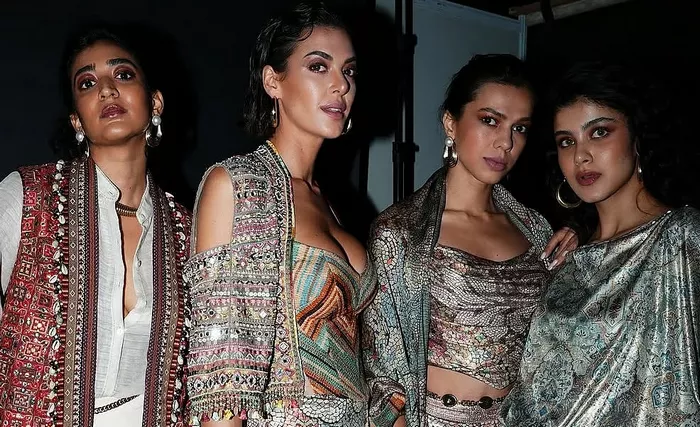In recent years, India’s leading couturiers have ventured into prêt wear, signaling a broader shift in the fashion industry. This shift acknowledges the evolving needs of Indian consumers, who now seek luxury that fits seamlessly into their daily lives, not just for special occasions. Esteemed designers, once known for their opulent craftsmanship, are now reimagining everyday wear for the modern Indian wardrobe.
Renowned designer Tarun Tahiliani aptly captures this sentiment, saying, “India has such a rich heritage of craft, and for too long, it’s been reserved for either bridalwear or couture. But why shouldn’t luxury be lived in?” Tahiliani’s prêt collections retain the essence of couture—meticulous detailing, impeccable structure, and signature aesthetics—yet they are reimagined into silhouettes that are wearable, versatile, and suited to the modern lifestyle.
Lakmé Fashion Week x FDCI has served as the stage for this evolution in Indian fashion, marking 25 years of groundbreaking moments. This event saw the second showcase of Tahiliani’s luxury prêt line, OTT. Known for his iconic India Modern narrative, Tahiliani has spent nearly three decades crafting maximalist couture, blending intricate techniques and textiles.
“Fashion has come a long way,” says Tahiliani. “In the early years, the industry was still finding its voice—there was immense talent, but the infrastructure wasn’t quite there. Now, craftsmanship is being reinterpreted beyond just bridalwear. The consumer has changed too—she’s well-traveled, aware, and looking for pieces that balance tradition with ease and versatility.”
Tahiliani’s past collections have embraced easy luxury with pioneering lehengas in airy fabrics, effortlessly elegant concept saris, red carpet-worthy gowns, and ornate anarkalis. Now, he sharpens his creative vision to blend contemporary finesse with a deep respect for heritage. “OTT is very much a response to how women live today. They need clothes that move with them, not just for special occasions, but for daily life. It takes the finest Indian techniques—draping, hand embroidery, fabric manipulation—and translates them into pieces that are wearable, effortless, and modern. The goal is to build a wardrobe where each piece complements the next, creating a distinctly India Modern way of dressing,” he shares.
This new collection reimagines hand-embroidered chikankari and Rabari craft, weaving traditional techniques into modern wardrobes with vintage-inspired styles. Dresses, jackets, and gilets exude a romantic, bohemian charm. Continuing his Art Series, Tahiliani revisits his 2015 collaboration with the Singh Twins, infusing their multicultural geometric prints into a refreshing summer palette of ecru, blush, sage, and taupe. These patterns come alive on breezy fabrics like linen, Chanderi, georgette, organza, and jersey—merging tradition with modernity.
For Tahiliani, the philosophy is personal. “I’ve always believed that clothes should enhance the person, not overpower them. The modern Indian woman is balancing multiple roles—she’s traveling, working, socializing—she needs a wardrobe that reflects that fluidity. It’s about giving women the building blocks of a wardrobe—pieces they can layer, mix, and make their own.”
Designed for the multifaceted urban woman, this collection balances ease with intricate detailing, offering versatility without sacrificing timelessness. OTT remains trend-agnostic and size-inclusive, celebrating adaptability in fashion. Tailored gilets and dhoti pants showcase Tahiliani’s skill in structure and movement, while Western silhouettes—trench coats, skirts, capes, and dresses—subtly reinterpret traditional Indian garments. The collection is both timeless and contemporary.
“There’s also a need for innovation—handloom doesn’t have to mean traditional. We need to experiment with textures, cuts, and treatments so these techniques don’t just survive, but thrive in a global landscape,” he emphasizes.
Chikankari’s ethereal lightness and Rabari embroidery’s raw earthiness anchor the collection, but their reinterpretations feel fresh and distinctly modern. “It’s not about nostalgia; it’s about evolution. These techniques don’t just add texture and depth—they ground it in a legacy while keeping it contemporary,” Tahiliani says. “Chikankari has this incredible lightness, an almost ethereal quality that feels timeless. Rabari craft, on the other hand, has an earthiness that adds a different dimension. What I love is the juxtaposition—both come from strong, rooted traditions, but when reinterpreted in a modern way, they take on a whole new meaning.” While Tarun Tahiliani Couture is about grandeur and opulence, OTT is about movement and versatility.
With pieces that embrace sustainability and seasonless fashion, this collection appeals to those who appreciate luxury while prioritizing practicality. Beyond aesthetics, the collection also aims to support sustainable Indian artisanal traditions. “The biggest challenge is ensuring sustainability—not just in terms of materials, but in making sure artisans have steady, long-term work. Craft can’t just survive on revival projects; it needs to be integrated into contemporary fashion in a way that keeps it relevant,” he says.
Looking ahead, Tahiliani envisions OTT as a constantly evolving wardrobe that grows with the women who wear it. “The idea is to build on the foundation—season after season, adding pieces that can be layered and styled in new ways. We’re also exploring new ways to work with craft, finding techniques to incorporate into modern wardrobes. Ultimately, OTT aims to become a living, breathing wardrobe for the contemporary Indian woman—timeless, versatile, and distinctly her own,” he concludes.
Related Topics
- Millennial High Heels and Gen Z’s Quest for Comfort
- Tyla Stuns on the Red Carpet at the 2025 Billboard Women in Music Awards
- Edna Dhahabu Revives the Tradition of the Hando Dress with a Modern Twist

